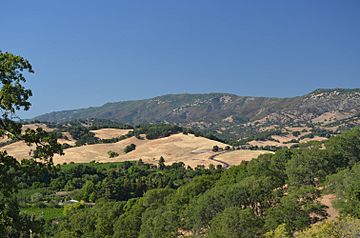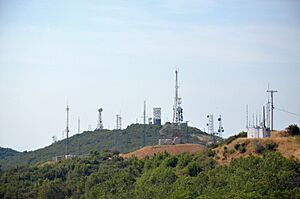Mount Vaca facts for kids
Quick facts for kids Mount Vaca |
|
|---|---|

Mt. Vaca and the Blue Ridge, high points of Solano County, as seen from upper Suisun Valley.
|
|
| Highest point | |
| Elevation | 2,822 ft (860 m) NAVD 88 |
| Prominence | 1,959 ft (597 m) |
| Listing | California county high points 53rd |
| Geography | |
| Location | Napa and Solano counties, California, U.S. |
| Parent range | Vaca Mountains |
| Topo map | USGS Mount Vaca |
Mount Vaca is a tall mountain in Northern California. It sits between Napa and Solano counties. This mountain is the highest point in the Vaca Mountains range. It's also the tallest spot in Solano County. Sometimes, Mount Vaca even gets snow in winter!
Why is it Called Mount Vaca?
The word Vaca means "cow" in Spanish. While cattle farming was important here long ago, Mount Vaca is not named directly after cows. Instead, it's named after a person!
The mountain and the nearby city of Vacaville are named for Juan Manuel Cabeza Vaca. In 1843, he and Juan Felipe Pena received a large land grant from Mexico. This land grant, called Rancho Los Putos, included the mountain we now call Mount Vaca.
How to Visit Mount Vaca
You can reach the top of Mount Vaca by car. There are two main roads that start in Vacaville, California. These are Mix Canyon Road and Gates Canyon Road. Both of these roads connect to Blue Ridge Road. Blue Ridge Road follows the top of the ridge all the way to the summit of Mount Vaca.
Weather Radar on Mount Vaca
The San Francisco Bay Area is surrounded by many mountains. These mountains can block weather radar signals. This creates "blind spots" in the weather prediction system. It means forecasters might miss important information about incoming storms.
To fix this, a TV station called KPIX-TV worked with the National Oceanic and Atmospheric Administration (NOAA). Together, they built a special Doppler weather radar on top of Mount Vaca. Before this, the mountain blocked radar views of storms coming from the Northwest. This could lead to unexpected floods, heavy rains, or strong winds.
The new radar system helps meteorologists see rain and temperature patterns more clearly. This means they can make much more accurate weather predictions for the Bay Area.
See also
 In Spanish: Monte Vaca para niños
In Spanish: Monte Vaca para niños



